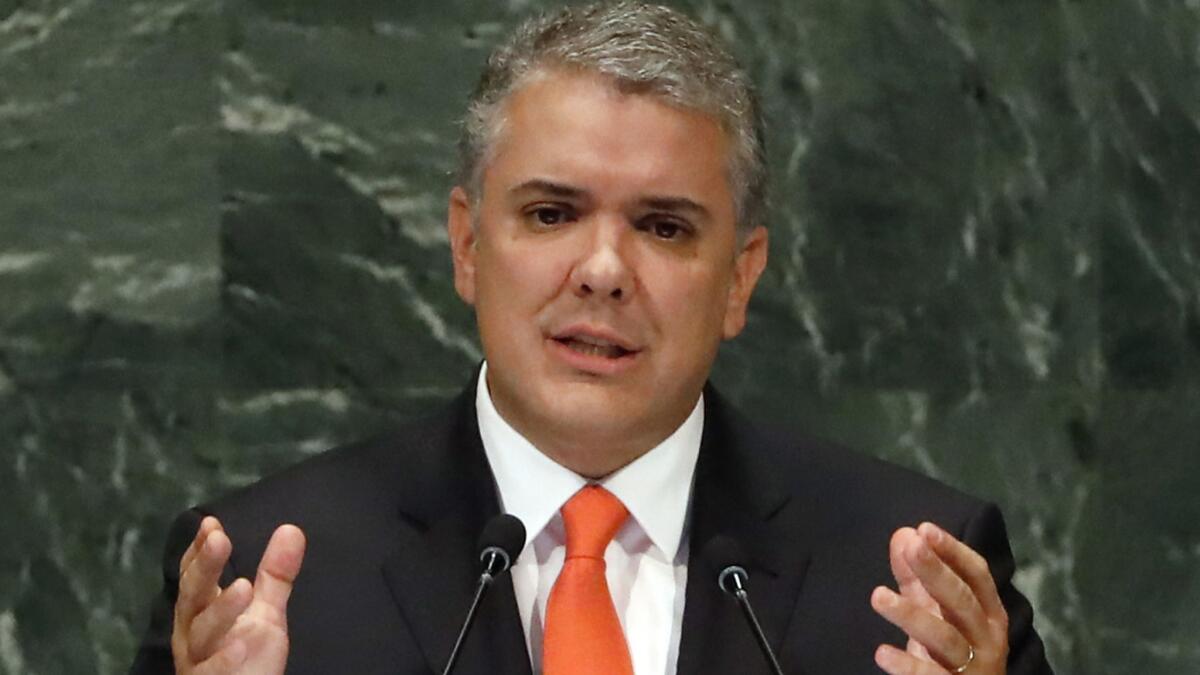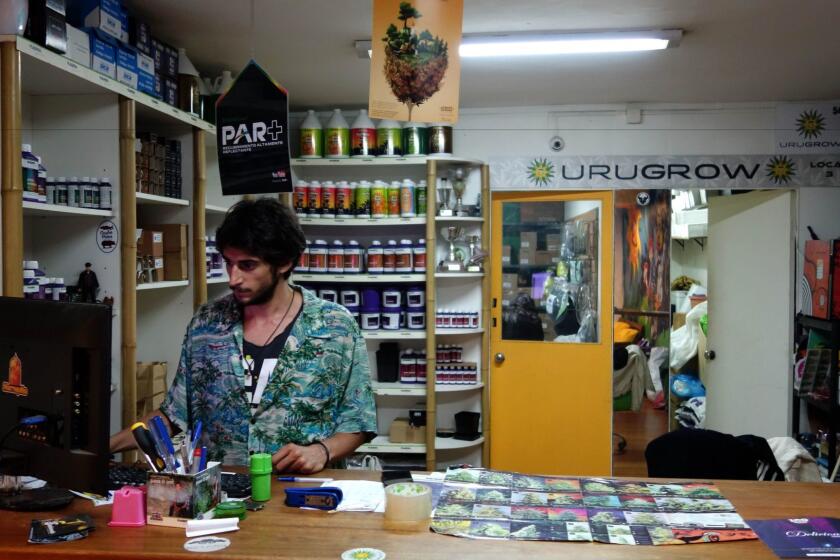Colombia lawmakers seek to take control of cocaine market. It’s a long shot

Colombian police officers at the traffic checkpoint sensed something fishy about an ambulance en route to Santa Marta, a city along the Caribbean Sea.
The driver appeared jittery.
Given the coronavirus-related mandatory national shutdown and ban on nonessential domestic travel, the officers figured they’d better inspect the emergency vehicle.
They found about 240 pounds of cocaine hydrochloride worth millions of dollars, apparently being transported illegally, along with a man they suspected was pretending to be ill. The officers confiscated the drugs and arrested him, his companion, a nurse and the driver.
A coalition of left-wing legislators who’ve grown weary of Colombia’s whack-a-mole anti-narcotics efforts recently included the details of the arrests in June in a proposal to stop the elaborate and often violent trafficking of cocaine that has plagued the South American country for decades.
The plan favored by the legislators is one that virtually everyone acknowledges would be highly difficult to integrate or enforce. It calls for the national government to take control of the drug market by purchasing coca leaf harvests and regulating cocaine sales. The challenges include cost, pushback from an international community that wants to maintain the status quo with regard to drug policy, and the potential reaction of an illegal drug empire that does not hesitate to use violence to get its way.
Nevertheless, the legislators who authored the bill, which is scheduled for congressional debate in October, insist the approach could reduce the waste of public funds, help protect Colombia’s environment and generate a better public health approach to the issue of drug consumption. Colombian adults already are allowed to carry up to a gram of cocaine for “personal use.”
Sens. Iván Marulanda and Feliciano Valencia, the authors, say change is needed as soon as possible because, although the national government signed a peace agreement with the Revolutionary Armed Forces of Colombia (FARC) in 2016, conflict persists among other guerrilla groups, FARC dissidents, ex-combatants, paramilitaries, drug traffickers, police and the military.
On top of more than 24,000 coronavirus-related deaths and 758,000 cases of infection as of Sunday, Colombia has suffered a slew of massacres this year, many of them linked to the ongoing conflicts.
Authorities and public officials say some deaths are tied to such problems as turf wars over coca fields and trafficking routes. This includes two high school students in the Nariño department of Colombia who were killed in August after visiting their school to submit their homework in person due to the pandemic and lack of internet connectivity.
“We do not wish to exploit the massacres that have been taking place for political gain,” said Sen. Gustavo Bolívar, who supports the coca regulation bill. “But they have a lot to do with the prohibition of drugs.”
Peasants who grow coca in the hot and humid lowlands here are engaged in a high-stakes battle of wills with the mighty United States.
If the bill were enacted, farmworkers would sell their coca harvests to the national government, which would keep tabs on illicit market rates in hopes of preventing sales to traffickers for a higher profit. Then the government would control cocaine distribution through its health network. Adults would be limited to one gram of cocaine per week.
Additionally, because some Indigenous groups have used the coca crop for millennia, most often chewed raw for energy and to treat ailments, the proposed legislation would permit the production for ancestral purposes. The pharmaceutical and nonpsychoactive use of coca, such as in food products, would also be allowed.
The bill also provides a sketch of what exports might look like. If implemented, the national government would have a monopoly on the export of all coca products, which would be made in accordance with receiving countries.
The proposed legislation comes in opposition to the administration of President Iván Duque, which is working to reinstate glyphosate aerial spraying to destroy coca crops, a practice suspended in 2015 after the World Health Organization linked glyphosate to cancer. Lawmakers who back the proposal also emphasize the herbicide’s ties to miscarriages and that it can pollute the air, soil and water, thereby destroying food crops and poisoning livestock. Resuming the use of glyphosate, they warn, could further erode one of the world’s most biodiverse countries, and push farmworkers out of their homes.
According to Marulanda, aerial spraying also makes no financial sense. At current market rates, he said, it would cost Colombia about $700 million to buy an entire annual coca harvest. In contrast, eradicating the same amount of coca crops with glyphosate would cost over $2 billion. Forced eradication, he said, is an exercise in futility, since many of the crops are often replanted.
The bill would expect the Colombian government to prioritize buying coca harvests from victims of its armed conflict, as well as Indigenous groups, communities of African descent, women who are heads of their households, impoverished people and people with disabilities. But if history is any indication, those who profit from trafficking Colombian cocaine would probably react to the proposed changes with violence.
To help farmworkers transition away from coca, Colombia launched the National Comprehensive Program for the Substitution of Illicit Crops shortly after the peace agreement. Often, former FARC combatants are enlisted to promote the program — sometimes at their own peril. Since the peace agreement was signed, hundreds of ex-combatants have been killed, including a former FARC commander who worked as a coordinator for the crop substitution program.
Colombians in rural areas also face other practical challenges and limited options.
“Regions are often so remote that it is impossible to even talk about growing pineapples or yuca or plantains or anything else,” said Sanho Tree, director of the Drug Policy Project at the Washington-based Institute for Policy Studies.
He posits the problem in terms of kilos, one of which is equal to a little over 2 pounds. “Think about it: Would you rather grow thousands of kilos of fruits and vegetables and get stuck in the mud, or would you rather grow one or two acres of coca and convert that into less than a kilo of coca paste, which you can ride on horseback or walk to the nearest village to sell?”
Tree, who began making fact-finding trips to Colombia 20 years ago, also said he would expect the production part of the bill to fail because the country had “way too much land in which to grow illicit crops,” and it would be hard to regulate it “if you don’t have rule of law.” It would also be difficult to get farmworkers to trust the government, he said, given that the Duque administration failed to uphold its end of the deal with the crop substitution program.
In 2019, the U.N. Office on Drugs and Crime reported that few of the 99,097 families enrolled in the program had received all of the payments owed to them, even though most had fulfilled their part of the agreement. Together, the farmworkers voluntarily eradicated nearly 89,000 acres of coca — or about 67,400 American football fields.
Tree also said government oversight of what got into consumers’ hands would be key to whether the legislation could be effective.
“As we saw with marijuana legalization in the U.S., regulated sales means being able to test the product for illicit pesticides, adulteration and purity — all of which help keep consumers safer. It shows consumers that there is a benefit from buying from a regulated supplier rather than from the illicit market,” he said. “This reduces profits to criminal organizations while enhancing tax collection.”
Diego Prandini is bent over in a small, brightly lit room, watering marijuana plants of all shapes and sizes.
Colombia, like most countries, is signatory to U.N. International Drug Control Conventions, treaties that underpin global anti-narcotics enforcement and could pose an obstacle for implementing the proposed reform. But this does not discourage the bill’s proponents. They point to Bolivia, which regulated coca leaf production for domestic consumption and developed a close working relationship with the U.N. Office on Drugs and Crime to keep track of coca crops with satellite imagery.
Legislators who support the bill also expect resistance from the U.S., which is pressuring Colombia to resume the aerial spraying of glyphosate and continues to send troops to the country to destroy coca crops. Citing the 2018 National Survey of Drug Use and Health, the most recent year for which data are available, the White House said in March that there were 1.9 million cocaine consumers in the U.S., of which about 86 die of overdose per year.
Colombian lawmakers who support coca regulation also worry about addiction. As a result, the bill prohibits advertising cocaine. To purchase the allotted quantity, consumers would first have to get doctor approval. Then they’d be required to register in a national database — a system akin to the sale of cannabis in Uruguay, which is meant to reduce product leakage and overconsumption.
Julián Andrés Quintero, director of Acción Técnica Social, a nonprofit advocacy group that aims to transform the country’s drug policies, helped Sens. Marulanda and Valencia draft their proposal. He also launched the #CocaReguladaPazGarantizada project at a special United Nations session in 2016.
The nonprofit group that year painted a mural in the heart of Bogotá, the capital, that featured a parrot, or perico — a slang term for cocaine — at the center, surrounded by coca leaves. To the right of the bird, the mural reads coca regulada. To its left, paz garantizada. Regulated coca, guaranteed peace.
The fact that the mural has not been defaced in four years, Quintero said, is a sign that its message is resonating with Colombians. The mural faces a major highway in Bogotá, which is a mecca for graffiti. Out there, the city’s artists paint over murals when they’re not impressed.
More to Read
Sign up for Essential California
The most important California stories and recommendations in your inbox every morning.
You may occasionally receive promotional content from the Los Angeles Times.












